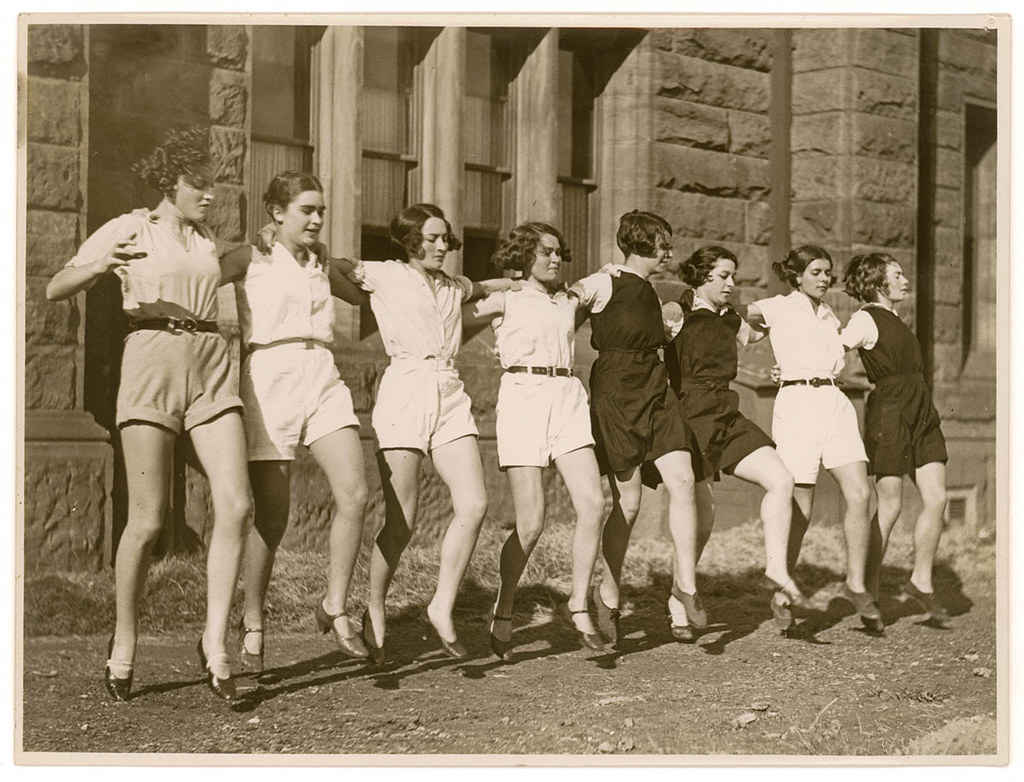 |
| Girls dancing, by Sam Hood. State Library of New South Wales |
While having a small community of belly dancers can be great for finding new friends and dance buddies, you also run the risk of competing against the same people for jobs and performances. Tempers can flair, people can get catty, and you soon wonder if you just have to become a ruthless belly dancer in order to get anywhere in life. But you miss the community aspect of it still. So which is better? Collaboration or competition?
Competition
So it's no good trying to make friends with the local dancers. The next best thing is to compete against them, right? Well, if you've got some tricks up your Isis wings that they don't, this can work for you. Maybe you went away to a festival and learned a new technique that no one knows yet. Or you've got an in with a popular troupe who decided you were the best dancer to impart their new wisdom on. Or you're the only Bollywood-Flamenco-Hip Hop-Ballet Fusion Belly Dancer in the area. Either way, you've got a unique style and everyone wants to learn it or watch it. So you win, right?Not always. Sure, it feels great to be the dancer in demand when the 'popular' crowd didn't think you were fit to fold their veils, but you lose a lot, too. If you don't have a skill or style that's in demand, or that people want to learn or watch, you might have the urge to resort to other tactics, such as undercutting other dancers, turning new dancers against your rivals, or even just plain old sabotage. Undercutting is one of the biggest ethical breaches you can make as a belly dancer, spreading stories about other dancers is plain rude, and sabotage is just outright wrong. And, in the end, you have to deal with all the stress of constantly staying on top of your skill, learning new things so that you can always be the biggest dancer on the block, and you might never have any dancer friends. Sure, you'll have tons of followers, but it's hard to be best pals with people who want to learn how to be like you. It's a lonely way to live.
Collaboration
So why is collaboration good for you? Well, it opens the door to learning new things from other dancers. If you collaborate with a group of fellow dancers, each one of you brings something new and different to the table. You have a better chance of producing something unique. And collaborating with other dancers suddenly opens up your network. Each dancer in the group knows people you don't, and it'll be easier to get gigs and performance slots if you know someone who knows someone. Also, even just teaching classes is augmented by having a group of dancers work together. You've got automatic marketing. Your collaborators can talk you up to their students, or if they have a student who doesn't fit in their classes but might fit in yours, they can send them your way, and you can do the same for them. Everyone wins, right?Usually, yes. But with a group of dancers who always work together, you run the risk of becoming stagnant, and always doing the same thing. And if you've got shy members of the group, they might have some really great ideas, but are too afraid to express them for fear of getting shot down. You also might lose out on new blood if no one is willing to break into your group, if you make it too exclusive--you might even end up being the 'popular' kids on the block that everyone hates.
The Best Option
Which is better, than? Well, that's easy: both! It sounds crazy, but people who have studied group work versus solo work found that both styles, used together, work the best. Instead of brainstorming with your fellow dancers, brainstorm alone. When you meet up with your group, everyone reads off their ideas, and the merits of each get debated. Sure, if you all came up with something together, you might end up with a really great performance idea or new class to teach, but most of the time, people end up agreeing with the alpha in the group.By brainstorming alone and debating in a group, everyone has a chance to have their say, and you'll see even the shy dancers coming up with really creative ideas that you know you'd never think of. And if you advertise yourself as being open to new ideas from other dancers not in your group, you can always have a fresh crop of dancers who might want to collaborate on a new project, and you get to be part of something really great. By having other dancers come in and out of the group, you'll never stagnate or grow old, and you'll be well-liked and known as a group of creative dancers who always pulls out all the stops.
No comments:
Post a Comment